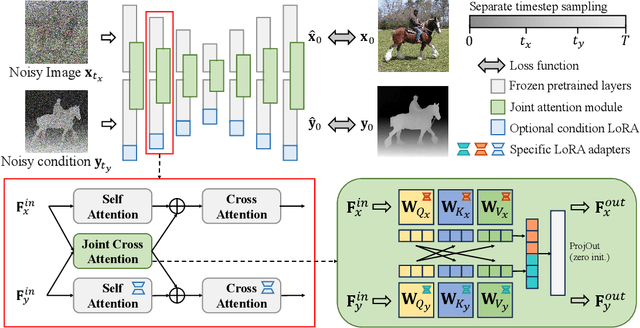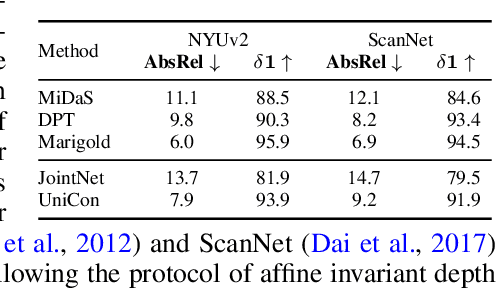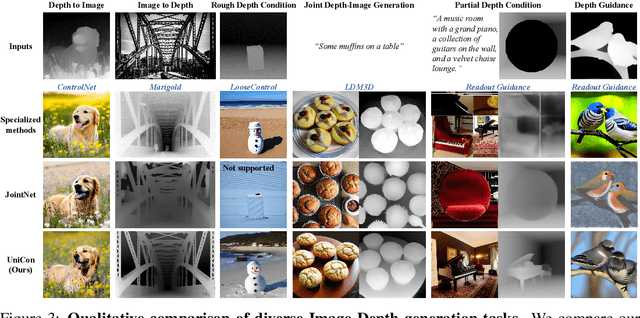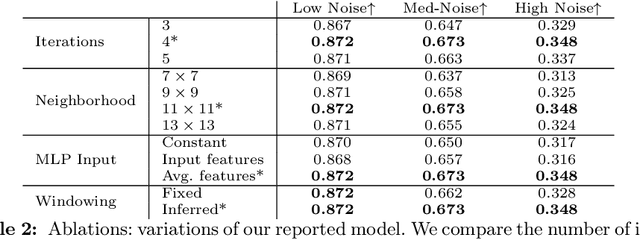Charles Herrmann
Derek
Motion Prompting: Controlling Video Generation with Motion Trajectories
Dec 03, 2024Abstract:Motion control is crucial for generating expressive and compelling video content; however, most existing video generation models rely mainly on text prompts for control, which struggle to capture the nuances of dynamic actions and temporal compositions. To this end, we train a video generation model conditioned on spatio-temporally sparse or dense motion trajectories. In contrast to prior motion conditioning work, this flexible representation can encode any number of trajectories, object-specific or global scene motion, and temporally sparse motion; due to its flexibility we refer to this conditioning as motion prompts. While users may directly specify sparse trajectories, we also show how to translate high-level user requests into detailed, semi-dense motion prompts, a process we term motion prompt expansion. We demonstrate the versatility of our approach through various applications, including camera and object motion control, "interacting" with an image, motion transfer, and image editing. Our results showcase emergent behaviors, such as realistic physics, suggesting the potential of motion prompts for probing video models and interacting with future generative world models. Finally, we evaluate quantitatively, conduct a human study, and demonstrate strong performance. Video results are available on our webpage: https://motion-prompting.github.io/
A Simple Approach to Unifying Diffusion-based Conditional Generation
Oct 15, 2024



Abstract:Recent progress in image generation has sparked research into controlling these models through condition signals, with various methods addressing specific challenges in conditional generation. Instead of proposing another specialized technique, we introduce a simple, unified framework to handle diverse conditional generation tasks involving a specific image-condition correlation. By learning a joint distribution over a correlated image pair (e.g. image and depth) with a diffusion model, our approach enables versatile capabilities via different inference-time sampling schemes, including controllable image generation (e.g. depth to image), estimation (e.g. image to depth), signal guidance, joint generation (image & depth), and coarse control. Previous attempts at unification often introduce significant complexity through multi-stage training, architectural modification, or increased parameter counts. In contrast, our simple formulation requires a single, computationally efficient training stage, maintains the standard model input, and adds minimal learned parameters (15% of the base model). Moreover, our model supports additional capabilities like non-spatially aligned and coarse conditioning. Extensive results show that our single model can produce comparable results with specialized methods and better results than prior unified methods. We also demonstrate that multiple models can be effectively combined for multi-signal conditional generation.
High-Resolution Frame Interpolation with Patch-based Cascaded Diffusion
Oct 15, 2024Abstract:Despite the recent progress, existing frame interpolation methods still struggle with processing extremely high resolution input and handling challenging cases such as repetitive textures, thin objects, and large motion. To address these issues, we introduce a patch-based cascaded pixel diffusion model for frame interpolation, HiFI, that excels in these scenarios while achieving competitive performance on standard benchmarks. Cascades, which generate a series of images from low- to high-resolution, can help significantly with large or complex motion that require both global context for a coarse solution and detailed context for high resolution output. However, contrary to prior work on cascaded diffusion models which perform diffusion on increasingly large resolutions, we use a single model that always performs diffusion at the same resolution and upsamples by processing patches of the inputs and the prior solution. We show that this technique drastically reduces memory usage at inference time and also allows us to use a single model at test time, solving both frame interpolation and spatial up-sampling, saving training cost. We show that HiFI helps significantly with high resolution and complex repeated textures that require global context. HiFI demonstrates comparable or beyond state-of-the-art performance on multiple benchmarks (Vimeo, Xiph, X-Test, SEPE-8K). On our newly introduced dataset that focuses on particularly challenging cases, HiFI also significantly outperforms other baselines on these cases. Please visit our project page for video results: https://hifi-diffusion.github.io
MonST3R: A Simple Approach for Estimating Geometry in the Presence of Motion
Oct 04, 2024



Abstract:Estimating geometry from dynamic scenes, where objects move and deform over time, remains a core challenge in computer vision. Current approaches often rely on multi-stage pipelines or global optimizations that decompose the problem into subtasks, like depth and flow, leading to complex systems prone to errors. In this paper, we present Motion DUSt3R (MonST3R), a novel geometry-first approach that directly estimates per-timestep geometry from dynamic scenes. Our key insight is that by simply estimating a pointmap for each timestep, we can effectively adapt DUST3R's representation, previously only used for static scenes, to dynamic scenes. However, this approach presents a significant challenge: the scarcity of suitable training data, namely dynamic, posed videos with depth labels. Despite this, we show that by posing the problem as a fine-tuning task, identifying several suitable datasets, and strategically training the model on this limited data, we can surprisingly enable the model to handle dynamics, even without an explicit motion representation. Based on this, we introduce new optimizations for several downstream video-specific tasks and demonstrate strong performance on video depth and camera pose estimation, outperforming prior work in terms of robustness and efficiency. Moreover, MonST3R shows promising results for primarily feed-forward 4D reconstruction.
WonderWorld: Interactive 3D Scene Generation from a Single Image
Jun 14, 2024Abstract:We present WonderWorld, a novel framework for interactive 3D scene extrapolation that enables users to explore and shape virtual environments based on a single input image and user-specified text. While significant improvements have been made to the visual quality of scene generation, existing methods are run offline, taking tens of minutes to hours to generate a scene. By leveraging Fast Gaussian Surfels and a guided diffusion-based depth estimation method, WonderWorld generates geometrically consistent extrapolation while significantly reducing computational time. Our framework generates connected and diverse 3D scenes in less than 10 seconds on a single A6000 GPU, enabling real-time user interaction and exploration. We demonstrate the potential of WonderWorld for applications in virtual reality, gaming, and creative design, where users can quickly generate and navigate immersive, potentially infinite virtual worlds from a single image. Our approach represents a significant advancement in interactive 3D scene generation, opening up new possibilities for user-driven content creation and exploration in virtual environments. We will release full code and software for reproducibility. Project website: https://WonderWorld-2024.github.io/
DreamWalk: Style Space Exploration using Diffusion Guidance
Apr 04, 2024Abstract:Text-conditioned diffusion models can generate impressive images, but fall short when it comes to fine-grained control. Unlike direct-editing tools like Photoshop, text conditioned models require the artist to perform "prompt engineering," constructing special text sentences to control the style or amount of a particular subject present in the output image. Our goal is to provide fine-grained control over the style and substance specified by the prompt, for example to adjust the intensity of styles in different regions of the image (Figure 1). Our approach is to decompose the text prompt into conceptual elements, and apply a separate guidance term for each element in a single diffusion process. We introduce guidance scale functions to control when in the diffusion process and \emph{where} in the image to intervene. Since the method is based solely on adjusting diffusion guidance, it does not require fine-tuning or manipulating the internal layers of the diffusion model's neural network, and can be used in conjunction with LoRA- or DreamBooth-trained models (Figure2). Project page: https://mshu1.github.io/dreamwalk.github.io/
Lumiere: A Space-Time Diffusion Model for Video Generation
Feb 05, 2024



Abstract:We introduce Lumiere -- a text-to-video diffusion model designed for synthesizing videos that portray realistic, diverse and coherent motion -- a pivotal challenge in video synthesis. To this end, we introduce a Space-Time U-Net architecture that generates the entire temporal duration of the video at once, through a single pass in the model. This is in contrast to existing video models which synthesize distant keyframes followed by temporal super-resolution -- an approach that inherently makes global temporal consistency difficult to achieve. By deploying both spatial and (importantly) temporal down- and up-sampling and leveraging a pre-trained text-to-image diffusion model, our model learns to directly generate a full-frame-rate, low-resolution video by processing it in multiple space-time scales. We demonstrate state-of-the-art text-to-video generation results, and show that our design easily facilitates a wide range of content creation tasks and video editing applications, including image-to-video, video inpainting, and stylized generation.
Efficient Hybrid Zoom using Camera Fusion on Mobile Phones
Jan 02, 2024Abstract:DSLR cameras can achieve multiple zoom levels via shifting lens distances or swapping lens types. However, these techniques are not possible on smartphone devices due to space constraints. Most smartphone manufacturers adopt a hybrid zoom system: commonly a Wide (W) camera at a low zoom level and a Telephoto (T) camera at a high zoom level. To simulate zoom levels between W and T, these systems crop and digitally upsample images from W, leading to significant detail loss. In this paper, we propose an efficient system for hybrid zoom super-resolution on mobile devices, which captures a synchronous pair of W and T shots and leverages machine learning models to align and transfer details from T to W. We further develop an adaptive blending method that accounts for depth-of-field mismatches, scene occlusion, flow uncertainty, and alignment errors. To minimize the domain gap, we design a dual-phone camera rig to capture real-world inputs and ground-truths for supervised training. Our method generates a 12-megapixel image in 500ms on a mobile platform and compares favorably against state-of-the-art methods under extensive evaluation on real-world scenarios.
Boundary Attention: Learning to Find Faint Boundaries at Any Resolution
Jan 01, 2024



Abstract:We present a differentiable model that explicitly models boundaries -- including contours, corners and junctions -- using a new mechanism that we call boundary attention. We show that our model provides accurate results even when the boundary signal is very weak or is swamped by noise. Compared to previous classical methods for finding faint boundaries, our model has the advantages of being differentiable; being scalable to larger images; and automatically adapting to an appropriate level of geometric detail in each part of an image. Compared to previous deep methods for finding boundaries via end-to-end training, it has the advantages of providing sub-pixel precision, being more resilient to noise, and being able to process any image at its native resolution and aspect ratio.
Zero-Shot Metric Depth with a Field-of-View Conditioned Diffusion Model
Dec 20, 2023Abstract:While methods for monocular depth estimation have made significant strides on standard benchmarks, zero-shot metric depth estimation remains unsolved. Challenges include the joint modeling of indoor and outdoor scenes, which often exhibit significantly different distributions of RGB and depth, and the depth-scale ambiguity due to unknown camera intrinsics. Recent work has proposed specialized multi-head architectures for jointly modeling indoor and outdoor scenes. In contrast, we advocate a generic, task-agnostic diffusion model, with several advancements such as log-scale depth parameterization to enable joint modeling of indoor and outdoor scenes, conditioning on the field-of-view (FOV) to handle scale ambiguity and synthetically augmenting FOV during training to generalize beyond the limited camera intrinsics in training datasets. Furthermore, by employing a more diverse training mixture than is common, and an efficient diffusion parameterization, our method, DMD (Diffusion for Metric Depth) achieves a 25\% reduction in relative error (REL) on zero-shot indoor and 33\% reduction on zero-shot outdoor datasets over the current SOTA using only a small number of denoising steps. For an overview see https://diffusion-vision.github.io/dmd
 Add to Chrome
Add to Chrome Add to Firefox
Add to Firefox Add to Edge
Add to Edge